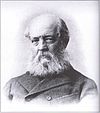Hanging Hills
| Hanging Hills | |
|---|---|
igneous and sedimentary |
The Hanging Hills of south central
Geography


Located within the towns of Meriden, Southington, and Berlin, the range, roughly horseshoe-shaped with cliff faces oriented south and west, includes, from east to west, Cathole Mountain 515 feet (157 m), South Mountain 767 feet (234 m), East Peak 976 feet (297 m), and West Peak 1,024 feet (312 m). Castle Craig is a small stone tower built in 1900 on East Peak. The Metacomet Ridge extends north from the Hanging Hills as Short Mountain and Ragged Mountain and southeast as Lamentation Mountain.
The south, east, and west sides of the Hanging Hills drain into the Quinnipiac River, thence into Long Island Sound; the north side into the Mattabesset River, to the Connecticut River, thence to Long Island Sound. Several notable reservoirs and natural bodies of water are located within the Hanging Hills or beneath its slopes, including Kenmere Reservoir, Hallmere Reservoir, Elmere Reservoir, Beaver Pond, Silver Lake, Mirror Lake, and Slopers Ponds.[2][3] Merimere Reservoir, nestled between South Mountain and East Peak and punctuated by the rocky mass of Mine Island, is considered particularly scenic.[4]
History
The Hanging Hills' Hubbard Park was financed by Walter Hubbard, local entrepreneur and president of the Bradley & Hubbard Manufacturing Company. Hubbard elicited the assistance of eminent landscape architect Frederick Law Olmsted in drawing up the design.[5]
.Geology
Ecosystem
The Hanging Hills host a combination of
The Hanging Hills are also an important seasonal

Recreation
The Hanging Hills are a popular outdoor recreation resource. Hubbard Park features a bandshell and flower gardens and is the site of a variety of local festivals and concerts, most notably the spring Daffodil Festival.
Conservation
Much of the Hanging Hills have been conserved as parkland, municipal water supply, or conservation easement. Private landowners also hold significant acreage, particularly on the east and north sides of the range. In 2000, the Hanging Hills were included in a study by the
A number of regional and local non-profit organizations are active in conserving the landscape and ecosystems of the Hanging Hills, most notably the Connecticut Forest and Park Association, the Meriden Land Trust,[13] and the Berlin Land Trust.[14]
See also
Adjacent summits:
| East > | North ↑ | South ↓ |
|---|---|---|
 |
 |
 |
References
- ^ a b c Farnsworth, Elizabeth J. (2004) "Metacomet-Mattabesett Trail Natural Resource Assessment." Archived 2007-08-07 at the Wayback Machine. Retrieved November 20, 2007.
- ^ a b c "Hubbard Park Hiking Trails" (PDF). Meriden Land Trust. Archived from the original (PDF) on April 12, 2012. Retrieved March 5, 2012.
- ^ DeLorme Topo 6.0 (2006). Mapping Software. DeLorme, Yarmouth, Maine.
- ^ Connecticut Windows on the Natural World. Retrieved December 13, 2007.
- ^ a b City of Meriden Archived 2009-08-21 at the Wayback Machine. Retrieved December 13, 2007
- ^ This Week in Amateur Radio. Retrieved December 13, 2007
- ^ Raymo, Chet and Maureen E. (1989) Written in Stone: A Geologic History of the Northeastern United States. Chester, Connecticut: Globe Pequot.
- ^ The Traprock Wilderness Recovery Strategy Archived 2007-08-16 at the Wayback Machine. Retrieved December 13, 2007
- ^ "Meriden Daffodil Festival".
- ^ "Meriden Cliffs — Ragged Mtn Foundation".
- ^ Connecticut Walk Book: A Trail Guide to the Connecticut Outdoors. 17th Edition. The Connecticut Forest and Park Association. Rockfall, Connecticut. Undated.
- ^ Monadnock, Metacoment, Mattabesett National Scenic Trail Study Archived 2007-10-08 at the Wayback Machine. Cited Nov. 4, 2007.
- ^ "Meridenlandtrust.com". Archived from the original on 2007-12-16. Retrieved 2007-12-13.
- ^ Berlinlandtrust.org Archived 2007-12-13 at the Wayback Machine
